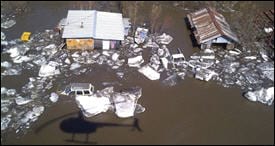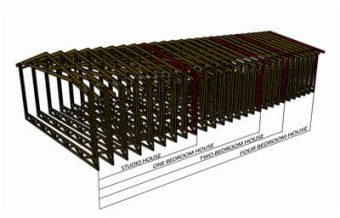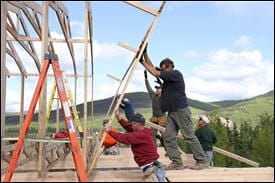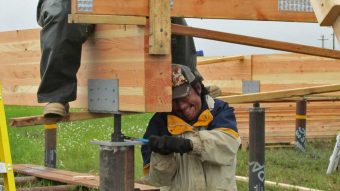Crooked Creek Prototype Home
 In May 2011, a flood destroyed about a quarter of the homes in Crooked Creek, a small village on the north bank of the Kuskokwim about 140 miles northeast of Bethel. Three and a half months later, volunteers framed the first replacement home in a single day, thanks to the quick reaction and unique collaboration of a state agency, native corporation, local community, gold mine, faith-based groups and a nonprofit research center.
In May 2011, a flood destroyed about a quarter of the homes in Crooked Creek, a small village on the north bank of the Kuskokwim about 140 miles northeast of Bethel. Three and a half months later, volunteers framed the first replacement home in a single day, thanks to the quick reaction and unique collaboration of a state agency, native corporation, local community, gold mine, faith-based groups and a nonprofit research center.
After the flood, the Alaska Division of Homeland Security and Emergency Management, which had already contracted CCHRC to work on emergency building designs for rural Alaska, asked the research center to design energy-efficient replacement homes before winter. That left only a couple of months to design the homes and put together a comprehensive materials list—an incredibly expedited schedule.
The budget was another major challenge. Without federal relief funding, each house had only $78,000 to work with ($44,836 in state aid plus donations from The Samaritan’s Purse relief organization). This tight budget forced designers to be creative with materials and transportation. Materials—such as spray foam insulation—were selected for being packable and easy to transport. They were either barged to Crooked Creek via ocean and river or flown to nearby Donlin Mine and then transported to the village via helicopter. Labor was provided entirely by volunteers from Samaritan’s Purse and Christian Reform World Relief Committee.
Partnerships
Tremendous teamwork between many organizations made this project a success.
- The Alaska Department of Homeland Security and Emergency Management spearheaded the project, provided the base funding, and coordinated the many groups
- Cold Climate Housing Research Center provided an assessment of the site, the home designs, and a comprehensive materials list
- Regional Native Corporation Calista Corp. donated gravel for the new building sites
- Local volunteers prepared the building pads
- AVCP Regional Housing Authority advised other agencies on the logistics of delivering materials to a remote village on the Kuskokwim
- Nearby Donlin Gold mine workers helped re-install Internet services and provided pilots to transport materials
- Samaritan’s Purse contributed more than $300,000 for materials and used its aircraft to move supplies and personnel in and out of Crooked Creek
- United Methodist Committee on Relief made a $25,000 donation for long-term recovery items such as mattresses, clothing, cooking utensils, and other household goods that were lost in the flood
- Christian Reform World Relief Committee contributed $5,000 for long-term recovery efforts
- Alaska Voluntary Agencies Active in Disaster (VOAD) formed a long-term recovery committee to help purchase and install various personal property items for those who lost essential household items
- The Kuskokwim Corporation and the Bureau of Indian Affairs helped locate viable land sites for the rebuild
- The Mennonite Disaster Service and United Methodists contributed funding.
Building Form
 The design was tailored to the local climate as well as the budget and time constraints of the project. The homes were made of pre-built wood trusses, designed and built by Alaska Engineered Truss of Kenai, that comprise the floor, walls and roof. The trusses shipped in one piece and were simply tipped up during framing, expediting construction. This also allowed for flexible floorplans, a major benefit since the 10 replacement homes needed to be an assortment of sizes.
The design was tailored to the local climate as well as the budget and time constraints of the project. The homes were made of pre-built wood trusses, designed and built by Alaska Engineered Truss of Kenai, that comprise the floor, walls and roof. The trusses shipped in one piece and were simply tipped up during framing, expediting construction. This also allowed for flexible floorplans, a major benefit since the 10 replacement homes needed to be an assortment of sizes.
The homes have a warm thermal envelope with 7 inches of spray foam in the walls, floor and roof. Metal siding makes up the exterior. The design is energy efficient and will prevent condensation in the envelope.
Construction
 Five homes needed to be relocated to lots on higher ground and the other four needed to be built on gravel pads that elevated the houses two feet above the high watermark of the flood to prevent future flood damage.
Five homes needed to be relocated to lots on higher ground and the other four needed to be built on gravel pads that elevated the houses two feet above the high watermark of the flood to prevent future flood damage.
The homes were constructed by 20 skilled volunteers. The single-truss design allowed a home to be framed in just one day.
Heating, Indoor Air Quality and Energy Use
Residents were given the option to choose one heating appliance for their home. Each chose a wood-burning stove as their primary heating source. The homes also contain a exhaust-only mechanical ventilation system with Fresh 80 inlets.
Future replacement housing
CCHRC is working with DHSE&M to develop housing concepts for each region in Alaska that can both respond to disaster and make homes more sustainable in every way. “The end goal is to start designing homes and communities to be less susceptible to natural disasters,” said Aaron Cooke, a CCHRC designer who worked on the project.










